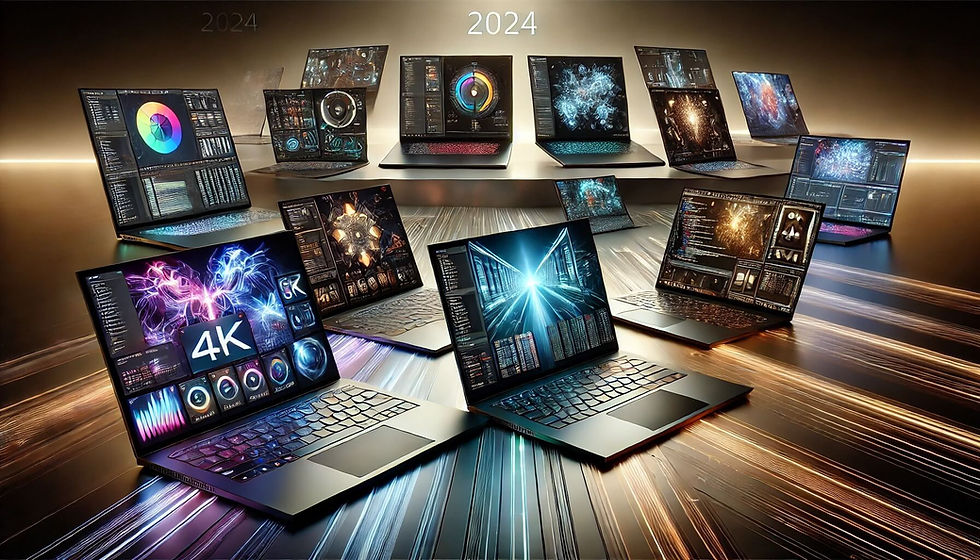Top 6 Latest Tech Trends to Watch in 2025
- Elite Tech Insights

- Apr 24
- 3 min read
Updated: Jul 23
Staying on the cutting edge is crucial for creators, entrepreneurs, and tech enthusiasts alike. As we move deeper into 2025, several breakthrough innovations are poised to reshape industries—from how we interact with devices to the very infrastructure of the internet. Here are the six latest tech trends you need to know about, along with tips on how to leverage them for your projects and content strategy.

1. Generative AI and Foundation Models
Generative AI isn’t just a buzzword—it’s transforming creative workflows and business operations. Next-gen foundation models can draft blog posts, design graphics, compose music, and even generate code based on simple text prompts. In 2025, look for:
Multimodal outputs: Models that seamlessly blend text, image, and audio generation.
Domain specialization: Tailored AI solutions for healthcare, finance, and education sectors.
On-device AI: Lightweight inference engines enabling real-time generation without compromising privacy.
How to use it: Embed AI-driven content tools into your site or workflow to automate brainstorming, A/B test variations, and personalize user experiences at scale.
2. Edge AI Meets the Internet of Things
Processing data at the “edge”—right where it’s generated—reduces latency, bandwidth costs, and privacy concerns. In 2025, expect:
Smart sensors: IoT devices with built-in machine learning that can detect anomalies or user behaviors locally.
5G-enabled edge nodes: Ultra-fast connectivity powering real-time analytics for autonomous drones, industrial robotics, and smart cities.
Energy-efficient chipsets: Specialized AI accelerators optimized for low-power environments.
How to use it: Develop prototypes that leverage edge AI for instant insights—think on-site quality control systems or augmented-reality shopping assistants that work offline.
3. Quantum Computing Breakthroughs
Quantum computing is leaving the lab and edging toward practical applications. Recent hardware advances now support more qubits with lower error rates, enabling:
Materials discovery: Simulating complex molecules for next-gen batteries and pharmaceuticals.
Cryptanalysis: Shaking up traditional encryption methods and driving adoption of post-quantum cryptography.
Optimized logistics: Tackling NP-hard problems like route optimization and supply-chain management.
How to use it: Keep an eye on quantum-as-a-service platforms—experiment with hybrid classical-quantum algorithms to benchmark performance improvements for specialized workloads.
4. Immersive Extended Reality (XR) Experiences
Augmented reality (AR) and virtual reality (VR) are converging into XR, offering fully interactive environments. In 2025:
Lightweight headsets: Devices under 300 g with inside-out tracking and full-color passthrough for mixed reality.
Spatial computing: Interfaces that blend holographic overlays with physical spaces for training, design reviews, and remote collaboration.
Social XR: Persistent virtual spaces where users interact with avatars in real time, from concerts to corporate boardrooms.
How to use it: Create XR prototypes for product demos or virtual events; integrate simple WebXR experiences on your site to give users a taste of immersive storytelling.
5. Sustainable and Green Technologies
Tech innovation must go hand-in-hand with planet health. Key green trends for 2025 include:
Next-gen batteries: Solid-state and silicon-anode cells boasting >500 Wh/kg energy density.
Carbon-capture AI: Machine learning models optimizing carbon sequestration processes at industrial scale.
Circular hardware design: Modular gadgets built for repairability and material reuse.
How to use it: Highlight sustainability credentials in your content, showcase eco-friendly product variants, or adopt green hosting services powered by renewable energy.
6. The Road to 6G and Ultra-Connected Networks
While 5G is still rolling out globally, research into 6G promises terabit-level speeds and sub-millisecond latency by the end of the decade. Early developments include:
Terahertz communication: Leveraging new spectrum bands for massive bandwidth.
AI-driven network management: Self-optimizing networks that dynamically allocate resources based on demand patterns.
Integrated satellite constellations: Seamless handover between terrestrial and space-based internet to ensure global coverage.
How to use it: Start planning for high-bandwidth applications like holographic telepresence or real-time digital twins—experiment with current 5G slices to prepare for the next leap.
Final Thoughts
2025’s tech landscape is brimming with possibilities—from AI that thinks and creates, to networks that span Earth and sky. By understanding these latest tech trends, you can position your blog, brand, or business at the forefront of innovation. Which of these breakthroughs will you explore first?




Comments